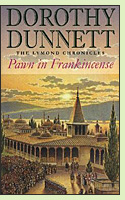Pawn in Frankincense
by Dorothy Dunnett
Reviewed by Margaret Tomlinson

Readers opening Pawn in Frankincense, the fourth novel in the Lymond Chronicles, are halfway through the series and about to be plunged, along with Francis Crawford of Lymond, into a radically new environment. After devastating betrayals during an attack by the Turks on Malta, of both Lymond personally and the Knights of St. John, the story moves east into the Ottoman Empire itself and the court of Suleiman the Magnificent and his shrewd consort Roxelana in the early 1550s.
Readers may wonder whether the many plot twists in the first three novels have exhausted the potential for new twists to surprise, horrify and delight them. Au contraire. Here, Lymond must defeat the most thoroughly evil and frighteningly intelligent of all the antagonists he has faced before. And the Turkish setting unveils a totally new social structure which the European characters must navigate and adapt to. If the courts of Ottoman Turkey are no more brutally violent or ostentatiously glamorous as those of England and France, the unfamiliar cultural medium through which the violence and glamour is expressed adds a special dimension of terror and awe for both characters and readers. Characters secondary in earlier novels come into their own in Pawn in Frankincense, particularly Philippa Somerville, almost as important here as Lymond. New characters like the willful and mysterious Marthe take the story in unforeseeable directions.
Dunnett's outstanding gift is to paint a meticulously textured background of real historical events and circumstances, while creating within it such fully realized fictional characters that they lend weight and emotional power to history itself. The nations of Christian Europe, even as they warred among themselves, hated and feared the the Turks. Dunnett's story brings this fear alive in the particular fears of her characters, along with wrenching moral dilemmas that will make readers wonder what they would do in similar circumstances. (1969; 486 pages)
More about Pawn in Frankincense at Powell's Books or Amazon.comOther novels set in the Ottoman Empire:
The Architect’s Apprentice by Elif Shafak (2015), about a boy whose work as an elephant keeper leads him to employment as an apprentice to the Ottoman sultan's chief architect in sixteenth-century Istanbul. More info
Kiraze by Solmaz Kamuran (2014), about a Jewish woman in sixteenth-century Ottoman Turkey who works as an intermediary between the women of the sultan's harem and the outside world. More info
The Sultan's Harem by Colin Falconer (2005), about a Tartar girl sold into slavery in the harem of Suleyman the Magnificent, who plots the downfall of her rivals in the harem and gains power by manipulating the sultan. More info
Nonfiction about life in the Ottoman Court:
Harem: The World Behind the Veil by Alev Lyle Croutier (1989). More info
Suleiman the Magnificent by Andre Clot (1992). More info
The Imperial Harem: Women and Sovereignty in the Ottoman Empire by Leslie P. Peirce (1993). More info
Online:
Roxelana, about the wife of Suleiman the Magnificent at Wikipedia
Back to Novels of the Renaissance
Back to Directory of Book Reviews